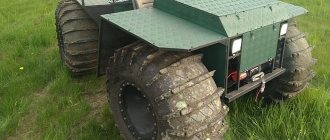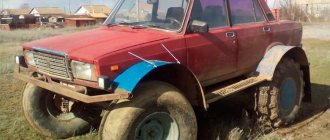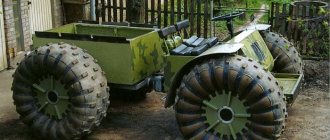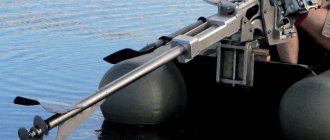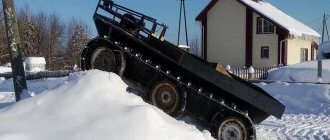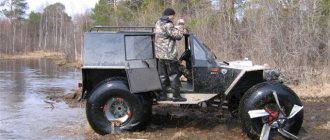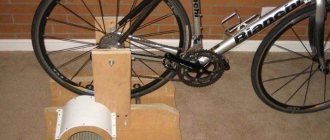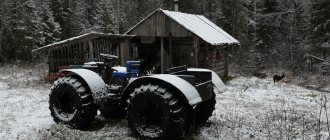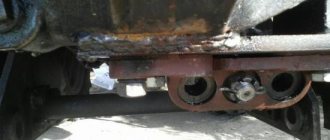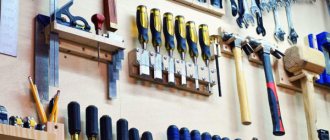Dear visitors to the “ Samodelkin Friend ” website, today we will look at the step-by-step process of assembling a fractured all-terrain vehicle on Alexander Murashov’s wheels. Video of testing and photo of assembly is attached. This all-terrain vehicle has two semi-frames connected to each other by a steering knuckle from the front axle from the UAZ, and is driven by the steering control of the VAZ. The semi-frames are welded from square-section corrugated pipe, the rear part of the frame has a conical shape tapering to the junction with the steering knuckle - this is necessary to increase the steering angle. This frame layout is borrowed from the T-150 tractor, that is, the operating principle of the fracture.
The engine is installed from the Domestic car OKA 0.7 l 33 l/s VAZ gearbox and axles, rubber wheels, VAZ rims modified to the inner diameter of the wheel, additional protection for the camera nipple. The cardan shafts are shortened and adjusted.
Additionally, a lightweight cabin and kung were made from corrugated pipe, the kung was covered with a banner.
Materials
- ICE OKA 0.7 33 l/s
- Bridge VAZ 2 pcs
- professional pipe
- VAZ gearbox
- the wheels are strong
- steering knuckle UAZ
- finishing materials: aluminum sheet, polycarbonate, banner.
Tools
- welding inverter
- Angle grinder (grinder)
- drill
- set of wrenches
- measuring tool
- skillful hands)
Step-by-step photos of assembling an all-terrain vehicle with your own hands.
The frame is welded from professional pipe, in front of you is its front part, on which the engine will later be installed.
Rear part of the frame.
Place where the bridge is attached to the frame.
Trying on the bridge.
The wheel rims are mounted on the axle hubs.
checkpoint
Two half-frames are connected to each other by a steering knuckle from the front axle of the UAZ. Brake system.
Shortening the driveshafts of an all-terrain vehicle. UAZ steering knuckle Please ATTENTION. The lever has been converted to a straight position.
Connection of shortened cardan shafts to the axle. Note! That torque is transmitted directly through the steering knuckle.
An engine from an OKA 0.7 l 33 l/s car is installed. The angle of rotation of one part of the frame relative to the other. Manufacturing of all-terrain vehicle rims.
Rim. Tire stripping. Note! The camera's nipple is well protected!
Steering and instrument panel installed.
Manufacturing of the body and kung of an all-terrain vehicle. The lightweight cabin is trimmed with polycarbonate.
Cladding with sheet aluminum. Engine and wiring connections. Video from all-terrain vehicle testing.
The topic of homemade vehicles is especially popular today. Many “traditional craftsmen” try to make carakat from standard means of transportation and special equipment. How can you make a budget karakat using a walk-behind tractor (even the simplest Neva will do). At first glance, doubts arise about the quality of the equipment, because visually it is a bulky and at the same time inconvenient machine. In fact, a caracat made from a walk-behind tractor, made with your own hands, shows simply excellent performance characteristics and can easily move in harsh climates and difficult terrain. And if we talk about moving through swamps, various river mouths, and in mud, then such an all-terrain vehicle will simply become an indispensable solution for every person.
What types of caracats are there?
Before figuring out how to independently make a karakat swamp rover from improvised mechanisms, it is necessary to take a closer look at the existing varieties of this kind of product. The Karakat swamp all-terrain vehicle is nothing more than a non-standard vehicle that moves with the help of wheels on which low-pressure tires are installed.
Among its main advantages:
- excellent maneuverability;
- low cost;
- maintainability;
- high power (depending on the spare parts used).
Such mechanisms are most often constructed independently on the basis of some equipment, for example, a tractor or walk-behind tractor. Existing models differ from each other not only in characteristics, but also in design. The most widespread are all-wheel drive and three-wheel drive devices.
All-wheel drive
All-wheel drive models seem to be the most popular transport option among consumers. They are equipped with 4 wheels, thanks to which the design is stable and has high maneuverability. Such a caracat can overcome even impressive obstacles without any problems, but its assembly will require two wheels of the same diameter.
To make such a swamp vehicle, the breaking with your own hands must be done correctly, otherwise there is a high probability of assembling an inoperable structure.
Three-wheeled
An equally popular modification can be considered models of swamp vehicles with three wheels. Such vehicles are lightweight and have the same cross-country ability as their all-wheel drive counterparts. Such an option will be optimal if you need to quickly make high-quality karakat. Do-it-yourself fracture can be done if you have the necessary equipment.
Stages of creating a homemade karakat
If you want to construct a Vologda swamp vehicle, the Karakat, or its other models at home, you should first of all purchase the necessary tools in advance, as well as acquire suitable components.
The complete list of necessary components and tools may vary and directly depends on the selected vehicle model that is planned to be manufactured. When analyzing the assembly process of such a product, it is necessary to highlight several important stages:
- Selection of the frame of homemade tractors or motor vehicles, which will become the basis of the future device.
- Planning and assembly of the rear axle and vehicle suspension.
- Selection and installation of suitable wheels.
- Installation of the power unit.
Since these types of elements seem to be key in the design of a swamp vehicle, it is advisable to consider the features of their selection and installation in more detail.
The main structural element is the frame, on which other components and assemblies will be installed in the future. Its choice directly affects the appearance of the future caracat, as well as its performance characteristics. Experienced craftsmen recommend using the frames of old domestically produced motorcycles, for example, IZH or Ural, since it is much easier to make a karakat from a motorcycle than from a car.
Spare parts from them are characterized by low cost, high strength and optimal characteristics for use as the basis for a swamp vehicle. After all, such three-wheeled models boast high maneuverability and maneuverability, which makes them universal. During the manufacturing process, it is advisable to use a frame drawing due to the complexity of the assembly.
Suspension
When designing the chassis, it is strongly recommended to give preference to an independent type of suspension. This is due not only to the ease of its manufacture, but also to its excellent characteristics.
Execution options
At home, 2 types of caracats are collected. Each has its own advantages and disadvantages.
All-wheel drive design
They take the Russian SUV as a basis - UAZ or “Also”. Niva is suitable for an inexpensive Chinese car, Lifan for example (Lifan) Solano 452.
In order to reduce weight, they change the standard engine to a motorcycle engine from the “or” Dnepr “Ural”.
- load capacity is large.
- Increased cross-country ability.
- Comfortable closed Reliability.
- cabin. If one of the axles fails, the car remains on the move.
- Minimum labor costs. Only minor changes are made to the design.
Disadvantages of all-wheel drive High:
- homemade cost.
- Heavy weight.
- Low Example.
The maneuverability of the all-wheel drive caracat is the ZIS model 5.
A convincing argument in favor of this design is the presence of differentials, thanks to which the car turns freely.
Three-wheeled all-terrain vehicle
Assembled on a motorcycle base. There are 2 wheels installed at the rear (car axle shafts or axle), and 1 at the front (on the fork).
If the operation of the vehicle is intended only in the summer season, a non-cabin is installed.
Otherwise, they attach a primitive aluminum profile from the booth.
- Light weight.
- High Compact.
- maneuverability dimensions.
- Weak traction (drive at 2 Low).
- wheels load capacity.
- A large amount of work to do independently during production.
In addition, the model with axle shafts turns poorly due to the lack of a differential. In early versions, a ski was installed in front. This type of car is easier to assemble, but it does not have buoyancy.
The option with a single-wheel front overcomes turned out to be more practical.
It is partly wetlands and rivers; does not go on if the bottom of the ice underneath has broken.
Reworking a walk-behind tractor
Walk-behind tractors are rightfully considered one of the most versatile types of agricultural machinery, which is why they are often used as the basis for various home-made units. Among them, home-made 4x4 mini tractors with a breakable frame are very popular, as well as caracats made from a walk-behind tractor, which in terms of technical indicators are in no way inferior to other types.
To successfully manufacture such a device from a walk-behind tractor, you will need to follow the following instructions:
- Weld the frame using a metal profile/pipe.
- Mount rear and front drives. To simplify the process, it is recommended to take the front axle, steering system, and other elements from the vehicle’s chassis.
- Install the motor, as well as the gearbox included in the design of the walk-behind tractor.
- Construct and secure the slopes, and then roll in the resulting structure.
It is important to note that for this type of swamp vehicle it is recommended to use a wheelbase with increased belt-type traction. Structures made from walk-behind tractors, as a rule, have impressive dimensions and can reach speeds of up to 70 km/h, which makes them universal and reliable off-road solutions.
In order for the karakat to have the necessary characteristics, it is necessary to use high-power walk-behind tractors, since the vehicle must not only move successfully, but also transport the driver, as well as various loads.
based on snowmobile walk-behind tractor, skis and bicycle parts
Agricultural work is carried out during the summer season. In winter, an idle walk-behind tractor engine can serve as a power all-terrain vehicle for driving through snowdrifts, which you can assemble yourself. With the arrival of spring he returns to Scheme.
snowmobile place
A three-wheeled layout is offered. Instead of a double ski at the front of the skating rink. no Cabin, the machine is intended for short-term use.
travel will be required
The following components are used:
- Bicycle frame.
- Cameras from a truck, for example Skis.
- KamAZ plastic (2 pcs.).
- Gearbox from an old DIO Honda scooter.
- Motoblock engine.
- Chains for torque transmission.
- Sprockets (2 pcs.).
- Gas tank.
- Couple of disabled person from wheelchair wheels.
- Metal barrel with a volume of Steel l.
- 200 shaft with bearings.
- Fire hose strip or tarp.
A welding machine, metalworking and grinder tools are used. To fix some units, bolts and nuts are used.
Assembly algorithm
snowmobile Construction is carried out in the following order:
- The engine from the walk-behind tractor is screwed to the front of the frame.
- Place a seat on your seat.
- Sprockets are welded to the gearbox shaft. Then attach the mechanism under the seat.
- Put sprockets on the chain.
- The shaft is inserted into the rear bushing. A large asterisk is fixed on it. It needs an increase in traction.
- Rollers are made with the diameters cut from the barrel attached to the wheels of a wheelchair. Their rims match.
- The rollers are mounted on the shaft and secured with bolts.
- They put truck tires on them, and the firefighters tie them with a hose.
- A bicycle handlebar is installed with it, and a double ski is attached to the fork. The control elements must be positioned at an angle to the surface, otherwise the snowmobile will not turn the ground.
- Install the Machine.
The gas tank overcomes deep snow and easily climbs steep slopes. By replacing the skis with a pontoon, you can turn it into an amphibious all-terrain vehicle.
Homemade caracat from a walk-behind tractor with your own hands
The topic of homemade vehicles is especially popular today. Many “traditional craftsmen” try to make carakat from standard means of transportation and special equipment. How can you make a budget karakat using a walk-behind tractor (even the simplest Neva will do). At first glance, doubts arise about the quality of the equipment, because visually it is a bulky and at the same time inconvenient machine. In fact, a caracat made from a walk-behind tractor, made with your own hands, shows simply excellent performance characteristics and can easily move in harsh climates and difficult terrain. And if we talk about moving through swamps, various river mouths, and in mud, then such an all-terrain vehicle will simply become an indispensable solution for every person.
Stages of karakat development
Conventionally, we can distinguish the following stages on how to assemble a floating caracat:
- Creating a Frame
- Making a pendant
- Creation and installation of wheels
- Engine and systems installation
Caracat frame
First of all, you need to choose a suitable frame for installing all the necessary equipment and units on it. It is desirable if it is a walk-behind tractor belonging to the medium or even heavy class of equipment.
In fact, even the most “advanced” karakat is nothing more than a homemade all-terrain vehicle, which is usually mounted on a frame with four (4x4) or even three wheels (tricycle). The choice of the number of wheels depends solely on the design features of the intended vehicle and the previously developed design.
The wheels must be “shod” with high-quality low-pressure tires; the structure is powered by an installed powerful internal combustion engine.
Suspension
The suspension of a walk-behind tractor will require special attention and precision on the part of the developer. At this stage, in addition to the suspension itself, the master will need to make a rear axle, which is done exclusively with his own hands.
Rear axle drawing example
The suspension provides a special design made of two separate parts connected together by hinges. In this case, the spars must mate with each other, for which a steering bushing is used. Ultimately, it is possible to form independent front and rear suspensions.
The main condition is to achieve exceptionally high suspension independence, because It is this indicator that allows the all-terrain vehicle to be operated in the most unpredictable places, guaranteeing the safety of the structure.
Maneuverability and cross-country ability should be the primary factors that you should pay attention to when making a homemade caracat design from a walk-behind tractor.
Do-it-yourself karakat wheels
Caracat wheels are, in fact, the most expensive product, which requires a lot of time to be spent on. You can either purchase ready-made disks or try to make them yourself. It is worth noting that almost all vehicles (karakats), made as homemade products, are equipped not with wheels directly, but with tires and low-pressure chambers. Especially for these purposes, it is best to choose products installed on trucks such as the Ural, KamAZ and others.
As an option, you can use wheels from the trailers of these vehicles - if possible, you can purchase tires and a tube from the K-700 model. The most important thing to pay attention to is that the wheels must be large enough, which will allow you to easily move off-road in the future, easily covering significant distances without the risk of overturning.
Engine and systems
Installation of the engine and other systems is carried out at the last stages of work. These operations are carried out when a suspension with prepared wheels is installed on the vehicle frame.
In addition to the engine, clutch systems, brake elements, as well as systems responsible for removing burnt fuel products from the mechanisms are mounted.
When the engine is installed, it will be necessary to conduct a full test of the karakat, then it can be operated.
It is worth noting that depending on the walk-behind tractor used as the initial unit, the power of the vehicle can be calculated.
For assembly you will need to use a standard set of tools and technological equipment and available materials. It is important to ensure the maximum possible safety of the vehicle driver and eliminate the possibility of accidents. A self-constructed karakat from a walk-behind tractor will allow you to move without problems in harsh weather conditions and will last for a long period of time without the need for regular repairs and expensive maintenance.
How to make a walk-behind tractor from a chainsaw
The following products and materials are used:
- Motorcycle steering wheel.
- Transmission from an old moped.
- Stainless steel pipes with a diameter of 20-30 mm.
- Wheels with pneumatic tires from a car or agricultural machinery. An alternative option is homemade metal rims with lugs. To make them you will need a steel sheet and a corner.
- Bolts and nuts.
The engine is removed from the chainsaw. It is recommended to take a professional tool with a 10-13 hp motor.
The work is performed in the following order:
- The stainless steel pipe is bent into a U-shaped frame. The ends of the “legs” should be bent upward.
- The structure is reinforced with jumpers made of the same material.
- The steering wheel is welded.
- The plate for installing the battery is secured using electric welding.
- A muffler is made from a piece of pipe with a diameter of 7 cm and a length of 250 mm. The internal space is filled with sawdust so that the size of the outlet hole is no more than 1.6 cm.
- A small U-shaped frame for the engine is made from a pipe with a diameter of 4 cm. Brackets for bolting are welded to the edge and in the middle.
- Install the motor on the frame and screw it on.
- The axle shafts reinforced with a cotter pin are attached and the wheels are installed on them.
- To complete the process, the steering wheel, gearbox and gas tank are attached.
All that remains is to test the car in field conditions.
DIY karakat
The main feature of this swamp vehicle is its reliable design. During production, I proceeded from the availability of serial units that our industry produces. As an all-terrain vehicle engine, I used the existing one from IZH-Planet. I installed forced air cooling on it from the SZD motorized stroller, popularly known as “Invalidka”.
The crankshaft was kept from the original planetary one, because The seat for the generator at the SZD is not suitable, a smaller one is needed. I installed the ignition coil on the swamp vehicle from IZH at 6 W (photo 1)
.
Frame, brakes and transmission
The supporting structure is the IZH-Planet frame. I digested and strengthened it using profile pipes 20x20x2.5 mm, 40x20x2.5 mm (photo 3)
.
The front fork measuring 40x40x2.5 mm was made from the same material (photo 4)
.
The peculiarity of the chain drive from the engine to the gearbox is the modification of the unit for installing the driven star on the gearbox input shaft. To relieve the load on the input shaft bearing and eliminate the possibility of bending, I installed a separate bearing with a torque transmission unit.
The node consists of:
✔ from a clutch disc from Oka, ✔ IZH-Planet gearbox cover with drive gear and bulk bearing, ✔ sheet of steel (3 mm thick, d 120 mm) for transmitting torque and mating the clutch disc with the drive gear, ✔ plates made of sheet steel (of the same thickness) to install the entire assembly at the Oki checkpoint
(photo 5)
.
The power transmission gear ratio was calculated using the formula:
N = n1хп2хпЗх. ni, where n is the gear ratio of each gear in the transmission.
I calculated it so that the torque that the engine develops (taking into account downshifts) does not exceed the permissible torque maintained by the Oki gearbox.
Braking system - VAZ-01 with brake drive from the handbrake cable. The cable was adapted to the standard motorcycle lever.
The chain tensioner was used from a VAZ-08 tension roller. The wheel drive was made from an Oka CV joint and a VAZ-01 axle shaft, connecting them by welding. I secured the axle shaft in its normal place (in the flange part cut off from the VAZ axle).
All-terrain vehicle wheels. I took wheel rims from BA3-13 as a basis and welded the spokes and rims on a homemade machine (consists of a construction pallet and plywood, 4 studs and a brake drum for fixing them) (photo 6)
.
Tires size 500×70-R20 were taken from a heavy all-terrain vehicle. I assembled them according to the “camera within a chamber” principle and tied them together with belts from a conveyor belt (photo7)
.
The karakat turned out to be light and with good cross-country ability!
Video selection
Karakat-all-terrain vehicle based on the Neva walk-behind tractor:
A lightweight all-terrain vehicle with the working title “Bruise”, as the body is sheathed in polycarbonate. In general, this is the first model where this light, warm and more or less durable material was used. So far there are no complaints about polycarbonate, this plastic should withstand frosts of up to 40 degrees and does not deteriorate in the sun, most importantly, it is much lighter than any iron and aluminum and cheaper.
The all-terrain vehicle turned out to be quite light for its size, capacity and large wheels. Approximate weight is about 600kg. Dimensions: length-3400 mm, width-1960 mm, cabin height 2100 mm, kung height 2350 mm.
Technical characteristics of the all-terrain vehicle
Rotation method
— “fracture” of the frame on the UAZ fist Wheel
formula
— 4x4, permanent all-wheel drive
Dimensions
— L*W*H /3400*1960*2350
Curb weight
— 650 kg
Load capacity
— land/water 300/150 kg
Maximum speed
— land/ water 25/1 km/h
Engine
- IZH-Planeta3, converted to liquid cooling
Chain gear
- chain pitch 19.05 mm, gearbox inverter = 2.13
Drive axles
- M-412, main pair inverter = 3.9
Tires
- Bel -79 1020*420-18, chamber
Discs
- homemade
Frame
- spatial, welded, made of profile pipes
Cabin
- semi-closed, single-seat
Body
- semi-closed, lined with polycarbonate
The all-terrain vehicle was built as a simple and budget option. The engine was planned from the SZD motorized stroller, but the Soviet heritage remains less and less and now it is difficult to find old engines and other elements as people sell everything for scrap. But we still managed to find other necessary parts for the “planetary” engine. The engine turned out to be prefabricated, based on Planet 3, but with the right half replaced for a 12-volt generator.
